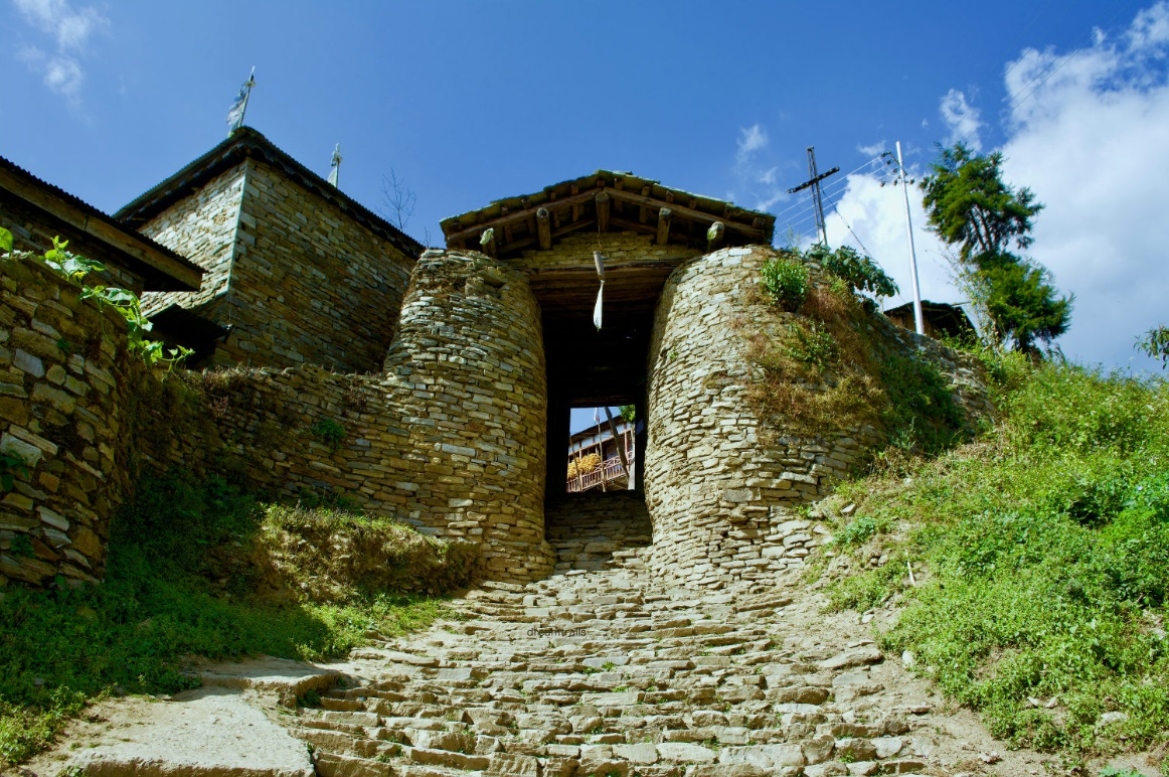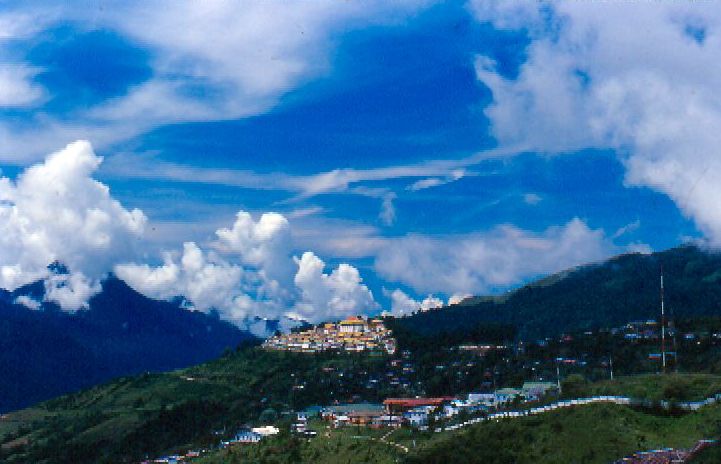|
Monpa
The Monpa ( (;, Chinese: 门巴族) are a major people of Arunachal Pradesh in northeastern India and one of the 56 officially recognized ethnic groups in China. Most Monpas live in the Indian state of Arunachal Pradesh, with a population of 50,000, centered in the districts of Tawang and West Kameng. As of 2020 there were 11,143 Monpa people living in Le / Lebo / Lebugou / Lebugou township of Cona / Tsona City in the south of Tibet Autonomous Region, where they are known as Menba (). Of the 45,000 Monpas who live in Arunachal Pradesh, about 20,000 of them live in Tawang district, where they constitute about 97% of the district's population, and almost all of the remainder can be found in the West Kameng district, where they form about 77% of the district's population. A small number of them may be found in bordering areas of East Kameng and Bhutan (2,500). They also share very close affinity with the Sharchops of Bhutan. Their language belongs to the Tibeto-Burman famil ... [...More Info...] [...Related Items...] OR: [Wikipedia] [Google] [Baidu] |
Arunachal Pradesh
Arunachal Pradesh (; ) is a States and union territories of India, state in northeast India. It was formed from the North-East Frontier Agency (NEFA) region, and India declared it as a state on 20 February 1987. Itanagar is its capital and largest town. It borders the Indian states of Assam and Nagaland to the south. It shares Borders of India, international borders with Bhutan in the west, Myanmar in the east, and a disputed 1,129 km border with China's Tibet Autonomous Region in the north at the McMahon Line. Arunachal Pradesh is claimed in its entirety by China as South Tibet as part of the Tibet Autonomous Region; China Sino-Indian War, occupied some regions of Arunachal Pradesh in 1962 but later withdrew its forces. As of the 2011 Census of India, Arunachal Pradesh has a population of 1,383,727 and an area of . With only 17 inhabitants per square kilometre, it is the least densely populated state of India. It is an ethnically diverse state, with predominantly Monpa p ... [...More Info...] [...Related Items...] OR: [Wikipedia] [Google] [Baidu] |
Tshangla Language
Tshangla is a Sino-Tibetan language of the Bodish branch closely related to the Tibetic languages. Tshangla is primarily spoken in Eastern Bhutan and acts as a lingua franca in the region; it is also spoken in the adjoining Tawang tract in the Indian state of Arunachal Pradesh and the Pemako region of Tibet. Tshangla is the principal pre-Tibetan language of Bhutan. Classification Tshangla is frequently assumed to be close to the Tibetic languages. Bradley (2002) includes in among the East Bodish languages. Van Driem (2011), however, leaves it unclassified within Sino-Tibetan, pending further research. Bodt (2012:188-189) classifies Tshangla as a Bodish language, but notes that Tshangla (like East Bodish) is related to, but not directly descended, from Classical Tibetan. Grollmann & Gerber (2023) note that Tshangla is not particularly closely related to Bodish at all and should be placed in a separate part of the Trans-Himalayan linguistic phylum. Varieties Tshangla is a d ... [...More Info...] [...Related Items...] OR: [Wikipedia] [Google] [Baidu] |
Sharchops
The Sharchops (, ; "Easterner") are the populations of mixed Tibetan, Southeast Asian and South Asian descent that mostly live in the eastern districts of Bhutan. Ethnicity The Sharchops are an Indo-Mongoloid people who migrated from Assam, Arunachal Pradesh, or possibly Burma, c. 1200 – c. 800 BC. Van Driem (1993) indicates that Sharchops are closely related to the Mönpa and that both are descendants of the indigenous Tibetic peoples (pre- Ngalop) of Bhutan. Due to the societal prominence and political power of Dzongkha-speaking Bhutanese, however, Sharchops are marginalized in Bhutan. The Sharchops are the largest ethnic group in Bhutan. Population The Sharchops comprise most of the population of eastern Bhutan, a country whose total population in 2010 was approximately 708,500. Although they have long been the largest single ethnic group in Bhutan, the Sharchop have been largely assimilated into the culturally and politically dominant Tibetic Ngalop culture. Together, t ... [...More Info...] [...Related Items...] OR: [Wikipedia] [Google] [Baidu] |
Tibeto-Burman
The Tibeto-Burman languages are the non- Sinitic members of the Sino-Tibetan language family, over 400 of which are spoken throughout the Southeast Asian Massif ("Zomia") as well as parts of East Asia and South Asia. Around 60 million people speak Tibeto-Burman languages. The name derives from the most widely spoken of these languages, Burmese and the Tibetic languages, which also have extensive literary traditions, dating from the 12th and 7th centuries respectively. Most of the other languages are spoken by much smaller communities, and many of them have not been described in detail. Though the division of Sino-Tibetan into Sinitic and Tibeto-Burman branches (e.g. Benedict, Matisoff) is widely used, some historical linguists criticize this classification, as the non-Sinitic Sino-Tibetan languages lack any shared innovations in phonology or morphology to show that they comprise a clade of the phylogenetic tree. History During the 18th century, several scholars noticed parallel ... [...More Info...] [...Related Items...] OR: [Wikipedia] [Google] [Baidu] |
Sherdukpen People
The Sherdukpen are an ethnic group of Arunachal Pradesh state of India. Their population of 9,663 is centered in West Kameng district in the villages of Rupa, Jigaon, Thongri, Shergaon, to the south of Bomdila. All of these are at elevations between 5000 and 6000 feet above sea level. Of late, some of them have settled in Kameng bari areas, a new settlement area under Bhalukpong circle. Society Sherdukpen society is divided into two classes: The Thong and Chao, The thong ( Higher caster) consist of Thongchi, Thongdok and Thongon. the former of which–the higher caste–are divided into eight clans. Marriage between inter-castes are considered taboo within the tribal society and are strongly discouraged. Local legend mentioned that the upper caste are the descendants of a Tibetan king (a grandson of Songtsän Gampo) and Ahom princess, of which they bore two sons. The Chao are the descendants of the king's porters and servants. The Sherdukpens migrate to Doimara (a l ... [...More Info...] [...Related Items...] OR: [Wikipedia] [Google] [Baidu] |
Tawang District
Tawang district (Pron:/tɑ:ˈwæŋ or təˈwæŋ/) is the smallest of the 26 Districts of Arunachal Pradesh, administrative districts of Arunachal Pradesh state in northeastern India. With a population of 49,977, it is the eighth least populous district in the country (out of Districts of India, 707). History Tawang is inhabited by the Monpa people. From 500 BC to 600 AD a kingdom known as Lhomon or Monyul ruled the area. The Monyul kingdom was later absorbed into the control of neighbouring Bhutan and Tibet. Tawang Monastery was founded by the Merak Lama Lodre Gyatso in 1681 in accordance with the wishes of the 5th Dalai Lama, Ngawang Lobsang Gyatso, and has an interesting legend surrounding its name, which means "Chosen by Horse". The sixth Dalai Lama, Tsangyang Gyatso, 6th Dalai Lama, Tsangyang Gyatso, was born in Tawang. Tawang was historically part of Tibet. The Simla Accord (1914), 1914 Simla Accord defined the McMahon Line as the new boundary between British India a ... [...More Info...] [...Related Items...] OR: [Wikipedia] [Google] [Baidu] |
Tsona County
Tsona City (, zh, s=错那市), formerly Tsona County, is a county-level city in Shannan Prefecture in the southeastern part of the Tibet region of China. Tsona means "The face of the ara Yumcolake" in Tibetan. It lies immediately to the north of the McMahon Line agreed as the mutual border between British India and Tibet in 1914. China has not accepted the 1914 border delineation, but treats it as the Line of Actual Control (LAC). Tsona also borders Bhutan on its southwest. History In 1354, the Phagmodrupa dynasty established Tsona County (''mtsho sna rdzong''). In the 17th century, sectarian rivalries developed between the Gelugpa sect that was in the ascendant in Central Tibet and the Drukpa sect that got consolidated in Bhutan. The Mera lama of the Merag-Sagteng region in present-day Bhutan, belonging to the Gelugpa sect, was chased out of his native village by the Drukpa forces. He fled to the neighbouring Tawang region. The people of Tawang were apparently indiffe ... [...More Info...] [...Related Items...] OR: [Wikipedia] [Google] [Baidu] |
East Bodish Languages
The East Bodish languages are a small group of non-Tibetic Bodish languages spoken in eastern Bhutan and adjacent areas of Tibet and India. They include: * Dakpa (Tawang Monpa) * Dzala * Nyen, including Mangde and Phobjib * Chali * Bumthang * Kheng * Kurtöp Overview "Bod" ( བོད) is the endonym for Tibet. The term "East Bodish" first appeared in Shafer (1955). He classified "Dwags" (Takpa) into the "East Bodish Unit" within the Bodish Branch of Sino-Tibetan. *Bodic Section **Bodish Branch ***West Bodish Unit ***Central Bodish Unit ***South Bodish Unit ***East Bodish Unit **Gurung Branch **Tshangla Branch ** Rgyalrong Branch Michael Aris mentioned the " Bum-thang" language spoken in areas such as " Tongsa", "Mangdelung", Kheng, and " Kurtö", which retains "the most archaic features of all the Bhutanese languages" George van Driem states that Bumthang, Kheng and Kurtöp could be considered dialects of a single language. Bhutanese anthropologist Kelzang Tas ... [...More Info...] [...Related Items...] OR: [Wikipedia] [Google] [Baidu] |
Tibetan People
Tibetans () are an East Asian people, East Asian ethnic group Indigenous peoples, native to Tibet. Their current population is estimated to be around 7.7 million. In addition to the majority living in the Tibet Autonomous Region of China, significant numbers of Tibetans live in the provinces of China, Chinese provinces of Gansu, Qinghai, Sichuan, and Yunnan, as well as in Bhutan, Tibetan refugees in India, India, and Nepal. The Tibetic languages belong to the Tibeto-Burman languages, Tibeto-Burman language group. The traditional or mythological explanation of the Tibetan people's origin is that they are the descendants of the human Pha Trelgen Changchup Sempa and rock ogress Ma Drag Sinmo. It is thought that most of the Tibeto-Burman speakers in southwest China, including Tibetans, are direct descendants from the Qiang (historical people), ancient Qiang people. Most Tibetans practice Tibetan Buddhism, although a significant minority observe the Indigenous Bon religion. There ... [...More Info...] [...Related Items...] OR: [Wikipedia] [Google] [Baidu] |
Tawang
Tawang is a town and administrative headquarter of Tawang district in the Indian state of Arunachal Pradesh. It lies on NH-13 section of Trans-Arunachal Highway. The town was once the headquarter of the Tawang Tract, which is now divided into the Tawang district and the West Kameng district. Tawang continues as the headquarters of the former. Tawang is the number one tourist destination of Arunachal Pradesh. Tawang became part of British Raj ruled India after the 1914 Simla Convention, where the McMahon Line placed it within the British Raj, though actual control remained loose. In 1951, Major Bob Khathing led an expedition and established full Indian administrative control over Tawang. Since then, it has been part of India. China continues to claim Tawang as its territory. It is situated 448 km north-west of state capital Itanagar at an elevation of approximately . It lies to the north of the Tawang Chu river valley, roughly south of the Line of Actual Control wit ... [...More Info...] [...Related Items...] OR: [Wikipedia] [Google] [Baidu] |




